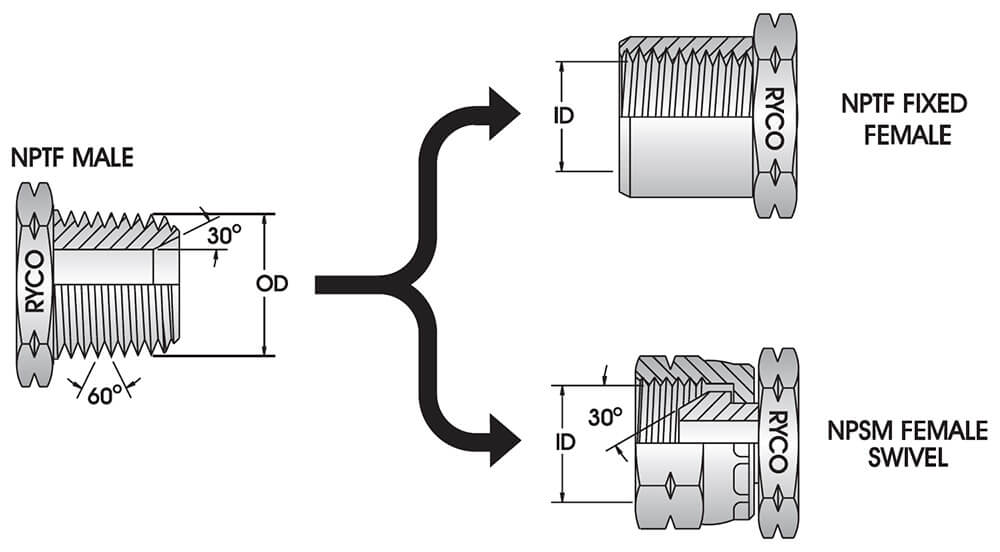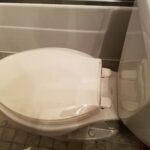As a homeowner, I’ve encountered various plumbing terms that can be confusing. One such instance was distinguishing between NPT and MIP fittings. Through my experiences and research, I’ve come to understand the differences and applications of these fittings, which I’d like to share to assist others facing similar challenges.
Measuring pipe thread size to determine the right thread type can be confusing. Thread dimensions are said to be of nominal size and don’t correspond with general units of measurements.
While using the right thread type is crucial for installing and maintaining equipment, it’s important to understand what pipe thread you need for your needs. Of course, you can force threads together, but if they don’t completely match, your fittings won’t seal.
We developed a comparison article about NPT vs. MIP to help avoid confusion and find the proper fitting. Note that different types of pipe threads are not interchangeable
MIP, NIP, and FIP work together, but are not compatible with any other types. Let’s begin by taking a look at various common pipe thread types:
NPT or NPS: This is the national pipe tapered or straight. It is most common in North America.
MIP or FIP: This is the Male or Female Iron Pipe. They have the same thread dimensions as National Pipe Thread (NPT).
BSP (T) or BSP (S): This stands for Standard pipe tapered or straight. It is most common in Europe.
Table of Contents
NPT and NPT Fitting
NPT basically stands for National Pipe Taper, which is a term defined by American National Standards Institute (ANSI). It is used to describe residential-grade pipe systems. This type of thread fitting can be used with FNPT or rather female NPT fitting in residential water as well as hydraulic systems.
If you’re wondering about the NPT size, the taper rate for all NPT threads is 1 inch of diameter in 16 inches of length measured by the change of diameter of the pipe thread over the distance of thread.
MIP and MIP Fitting
MIP typically stands for Male Iron Pipe. It is used to describe heavy-duty-grade metal pipe systems. A male iron pipe is referred to as a metal threaded-piping fitting that can be utilized with a Female Iron Pipe (FIP), fitting in heavy-duty piping systems for both industrial and residential purposes.
Is Male Iron Pipe the same as National Pipe Taper?
NPT threads are sometimes referred to as MPT (Male Pipe Thread), MNPT, or NPT (M), where “M” signifies male external threads and FPT (female pipe thread), NPT (F) for female internal threads. A compatible designation is Male Iron Pipe (MIP) and Female Iron Pipe (FIP).
NPT or rather national pipe thread has the same thread dimensions as a MIP (Male iron pipe) and FIP (Female iron pipe). That means NPT can fit MIP. Female iron pipe with internal thread can be replaced by NPT, iron pipe with internal thread, or international internal pipe like FPT.
However, while NPT is MIP compatible, it’s good to note that most pipe threads are not meant to be used interchangeably. NPT and MIP work together but do not match with any other types. Usually, the fitting itself will help you determine what thread type you need.
Another thing to note is that while NPT and NPTF are both designed to work together, NPT, unlike NPTF necessitates a hermetic seal. That means the requirements for NPT and NPTF are different for threads larger than half an inch and therefore cannot be overlooked.
Are Female NPT Threads Tapered?
The American NPT is a standard tapered pipe thread. Female and male tapered pipe threads screw together but require a sealant for a completely leak-free connection. Sealants are meant to fill any voids between the threads that could occur along the thread spiral.
If you’re wondering about how to tap NPT threads, there’s really nothing special about it. It’s just the size of the drill you use to make the hole. For a 1/8 NPT tap, you will require an “R” drill, then run your tap into the hole to the depth of the threads on the tap. You might want to use a 1/8 fitting as a thread gauge to make sure you have enough thread.
What is the Difference between NPT and MIP?
“MPT” stands for male pipe thread whereas “NPT” means national pipe thread. These are simply generic terms for that same pipe thread. In other words, male NPT and MPT mean the same thing.
Here is a quick comparison table between NPT vs. MIP fitting as used in piping systems.
| MIP | NPT | |
| Stands for | Male Iron Pipe | National Pipe Thread |
| Material | Copper, Iron, Steel, PVC, Plastic | PVC, Plastic |
| Application | Residential, Commercial, and Industrial Pining systems | Residential water and Hydraulic systems |
| MIP Fitting | NPT Fitting | |
| Shape | Straight | Angle between taper and center axis |
| Pitch Measuring | Threads Per Inch | Threads Per Inch |
| Truncation of roots and Flat | Flat or not | Flat |
| Tightening | Not applicable | General tightening standard is recommended |
| High-pressure application | Recommended | Not recommended |
| Compatibility | Female Iron Pipe fittings | Female National Pipe Tapered fittings |
| Recommended Sealant | Pipe dope or Teflon tape | Sealant compound or PTFE (Polytetrafluoroethylene) tape |
How to Know the Correct Pipe Thread and Size
Pipes threads and fittings refer to the actual dimensions of the fittings but do not necessarily specify the measurement of the pipe. In the plumbing industry, the measurement of thread size is known as “nominal” pipe thread size.
This indicates the inner diameter of the pipe size. The difference can get confusing as the industry has various terms that can be thrown around and if you’re not sure what to measure and where you may end up with incorrectly sized fitting.
You can determine the size of pipe threads (National Pipe Thread and National Pipe Tapered Female) by measuring the outer diameter and comparing it with the profile or by simply subtracting ¼ inch. For non-pipe threads, you can determine the size by measuring the outer diameter using a caliper.
What is MIP Thread?
A male pipe thread fitting is also known as a MIP, which stands for male iron pipe fitting. It is a type of fitting that has been used since the early 19th century to connect pipes together.
MIP fittings—combined with FIP and other types of fittings—are used in various commercial, industrial, and piping systems.
PVC, iron, copper, brass, and plastic are the most common materials for fittings.
These fittings are used in plumbing applications to connect pipes together with threaded connections called unions or joints.
MIP vs FIP
MIP (Male iron pipe) and FIP (Female iron pipe) are two types of threaded connections that can be used for plumbing purposes. They are both compatible with each other, as well as with NPT (National pipe thread).
The same dimensions of each thread mean that they can be interchanged in many different applications.
The difference between the two is that MIP pipes have male threads, while FIP or female iron pipes have female threads. (F) Female refers to a pipe that can accept a male fitting.
You can replace FIP with an internal thread with a threaded male fitting, or international standard female pipe threads.
NPT vs FIP
The National Pipe Thread (NPT) system is an American standard for threaded pipe fittings that was developed by the American National Standards Institute (ANSI).
It’s commonly used for gas and water lines, but it can also be found in air conditioning units, sprinkler systems, and many other types of equipment.
The dimensions of both NPT and FIP are the same, which means they can be used interchangeably in most cases.
The type of thread you’ll need mainly depends on the type of fitting you want to use. For example, if you want to connect a fitting with a male thread into a female threaded hole, then NPT is your best bet because it has the same thread dimensions as MIP or FIP fittings do.
It’s important that you don’t mix up the sizes: the requirements for NPT and NPTF vary for threads larger than half an inch.
Are NPT and MIP Compatible?
NPT and MIP threads are compatible but do not correspond to any other types. Despite their compatibility, it’s important to note that most threads weren’t designed to be used interchangeably. The type of thread that you need will usually be determined by the fitting.
NPT and MIP are both used for plumbing systems, but they each have their own advantages and disadvantages. The main difference between thes
Frequently Asked Questions
Q: Can NPT and MIP fittings be used interchangeably?
A: While MIP is a type of NPT, it’s essential to ensure compatibility based on the specific application and fitting requirements.
Q: Do I need to use sealant with NPT fittings?
A: Yes, NPT fittings typically require a thread sealant like Teflon tape to ensure a leak-free connection.
Disclaimer: This article is for informational purposes only. Always consult a professional plumber for specific advice related to your plumbing needs.


